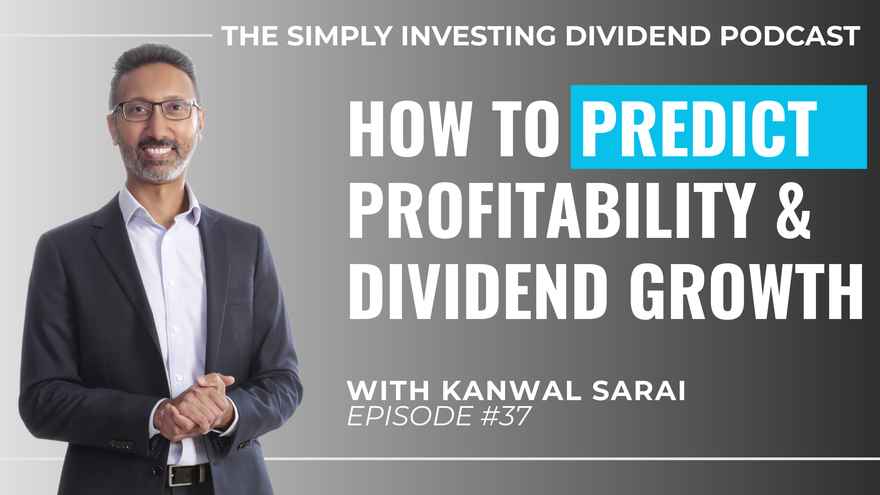Want to know the secret to predicting a company's future profitability? In this insightful episode, I cover the one key factor to determine a stock's profitability. Discover what stocks and shares are, how dividends serve as a tangible return on investment, and why investing in quality dividend stocks can be an excellent strategy for long-term success.
Get ready to dive into real-life examples of companies with a consistent history of paying dividends, such as Johnson & Johnson, Pepsi, and Coca-Cola. I also look at the elite club of Dividend Aristocrats and Dividend Kings - stocks that have increased dividends for 25 and 50 years, respectively. Plus, learn about the 12 Rules of Simply Investing, designed to save you time, minimize risk, and maximize gains. Join me on this journey to unlocking the true power of dividends and pave your way to financial success!
00:00
Before you invest, take a look at this one key factor that can help you predict future profitability for any company or stock. Hi, my name is Kanwal Sarai and welcome to the Simply Investing Dividend Podcast. In this episode, we're going to cover four topics. We're going to start with what is a stock or a share, then we're going to look at what is a dividend. After that we will look at proof of profitability, the one key factor I mentioned in the beginning. So we're going to go in detail on that. And the last topic is going to be some real life examples, and so we'll take a look at those.
00:46
Let's get started first with our topic number one What is a stock or a share? So a stock or a share for the purpose of this podcast, this episode, means the exact same thing. So some people will say I have five shares in Walmart, or they'll say I have stock in Coca-Cola. It means the same thing. So what exactly is it? Well, a stock or a share represents ownership in a company. So let's take a look, for example, at Walmart. Walmart has a little over 2.6 billion shares outstanding. If you were to buy all of the shares, you would own the entire company. Now, if you bought just five shares, or 10 or 100, you are still considered part owner of the company And as part owner of the company, you're entitled to share in the profits of this company. And those profits come to you in the form of dividends. And that's topic number two What is a dividend? So, like I said, a dividend is the company sharing its profits with you, the shareholder. So let's say, for example, a company is paying a dividend of $1 per share and you own a thousand shares, you will receive $1,000 every year for as long as you own those shares and as long as the company continues to pay the dividend, and in this case it's an annual dividend of $1 per share. Now you can spend those dividends if you wish or you can reinvest them. Those dividends are deposited as cash into your trading account. So it's up to you. You can reinvest them or you can spend them if you wish. Now it's important to note in this example you know you own a thousand shares, the company is paying a dividend of $1. You'll receive $1,000 every year, regardless of the stock price or regardless of what happens in the stock market. So the stock price can go up, it can go down, but as long as you own those shares and as long as the company is continuing to pay the dividend, like in this example, then you will receive $1,000 cash deposited into your trading account every single year.
03:15
Now let's get on to our next topic The key factor that helps to determine proof of profitability, because this is going to help you figure out is the company profitable and will it continue to be profitable. So what is proof of profitability? And the answer is it's the dividend. Now I'm going to share with you a quote which I think is really important here, from Kelly Wright. So he is a financial analyst, or expert, if you will, and I'm going to share with you exactly what he says. So this is a direct quote from Kelly Wright, and he says from our perspective and experience, the cash dividend is the more attractive profit path when investing in the stock market. Okay, so let's take a look at that again here. This is important From our perspective and experience, the cash dividend is the more attractive profit path when investing in the stock market.
04:34
In the first instance, the cash dividend is just that cash in hand, a tangible return on investment. Unless the company is committing outright fraud, a practice that will typically be short lived. The cash dividend is evidence that the company is indeed generating profits. A company cannot pay that which they do not have, so this is extremely powerful. So let's take a look at our next slide here. Okay, and I'm just going to summarize just two points here from the quote from Kelly Wright.
05:17
A dividend is tangible. It must be paid from cash. And where does the cash come from? It comes from profits, from the earnings, and we typically we will look at earnings per share. So that's how a company is able to pay the shareholders. They have to make money, they have to make profit in order to pay a dividend to the shareholders.
05:43
Now you might be thinking well, doesn't the dividend drop when the stock price drops? So let's take a look. Okay, so that's a valid question. So we're going to take a look at a real life example with a company called ADP. It's an American company, founded in 1949, headquartered in New Jersey, and they have 60,000 full time employees. So let's take a look at this price graph up on the screen. So you can see here this is the 45 year history of ADP, and the blue line or the purple line represents the stock price, and so you can see the stock price goes up and down. If you look carefully enough, you'll see that there's places in time where the stock price dropped by $5, 10, 15, even $20 a share, and that is a huge drop in the stock price.
06:46
But what happens to the dividend? So that's represented by the orange line on the screen And you can see that the dividend keeps going up every single year. It just keeps going up And you can see this is a 45 year history. In fact, the company has increased the dividend consecutively for 48 years. So how can a company continue to pay the dividend and continue to increase the dividend every year when its stock price drops? And you can see it in the graph The stock price drops quite a few times, right?
07:23
Stock prices go up and down all the time. How can they continue to pay a dividend when the stock price drops? And the answer is that the dividends are not paid from the stock price. The dividends are paid from earnings, and that's where the money comes from. Like I said before, the company has to be able to make a profit and Then they can afford to pay the dividend to the shareholders. Okay, so now in this graph We're looking at the same company, ADP, same time period, 45 years, and again you can see the stock price going up and down.
08:02
But now the orange line Represents the earnings, the earnings per share, and you can see there's a couple of times Over the last 45 years that the earnings have dropped a little bit. So Probably one, two, three, four, five sort of major periods in time where the earnings had dropped. But that's not bad. Out of a 45 year period. What we're looking for here is the long-term trend. And what is the long-term trend with the earnings? We can see that it's going up. So you can see the orange line here. The earnings per share over the last 45 years Continues to go up. So as long as the company Continues to be profitable, continues to make money, then they can afford to pay the dividend to the shareholders.
08:58
Here's another important point here. And increasing dividend also helps. Let's go back one second. And increasing dividend also helps to increase the share price. Now how does it do that? so Keep in mind, the dividend is the return on your investment. While you hold on to your shares and I've said this before the stock price can go up and down. Doesn't matter as long as you own, the note, those shares, if you don't sell those shares. As long as you hold on to them, you will keep getting dividends, and that dividend is the return on your investment While you hold on to your shares.
09:41
So let's take a look at That dividend yield. It's really simple It's the annual dividend divided by the share price. Now, to be more specific, it's the annual dividend divided by your purchase price, and that's going to tell us what is the return on your investment. So let's take a look at this example. We have a company that's paying a dividend of $1 That's an annual dividend per share and let's say you were to buy the shares today at $20 a piece. So that's the share price, or your purchase price today is $20 a piece. So we simply take the $1 dividend divided by 20 and we want to express that as a percentage and You can see it comes out to 5%. So 5% is Your dividend yield. It is your return on your investment While you hold on to the shares. And again, the stock market can go up and down. Share prices can go up and down, but your purchase price doesn't change because you bought the shares at $20 and As long as the company is paying a dividend in this example, your dividend yield is 5%. So that's a 5% annual return on your investment while you hold on to those shares.
10:58
Now let's see what happens to the dividend yield When the company increases the dividend. So now the company has increased the dividend to $1.50. So it started at $1, now it's at $1.50. Your purchase price is still $20. That hasn't changed. So now if we take $1.50 divided by 20 Express as a percentage, we can see it's 7.5%.
11:24
Now one more example let's say the company increases the dividend to $2. So now we take $2, which is the new dividend Divided by your share price or the purchase price, which is 20. So 2 divided by 20 Express as a percentage is 10%. So can you see what's happening here? What's happening to the dividend yield? every time the company increases its dividend, your dividend yield is going up. So in this example, you started off making 5% a year. Then, when the company increased the dividend, you were making 7.5%. Then, when they increase the dividend again, you're now making 10% return on your investment.
12:09
So what's happening here is every time the dividend goes up, the dividend yield goes up and that attracts more investors. And when more investors are attracted to the company, it's gonna drive up the share price. So why are more investors attracted to this company? Well, in this example, the dividend went from 5% to 7.5% to 10. So when the dividend yield goes up, investors are smart. They know that they can make more money. In this example, they can make 7.5%, 10%. They can make more than what they would make in a bank account or in a term deposit. So they will take their money, their capital, and put it towards good quality dividend stocks that are paying a higher dividend yield.
13:05
So let's take a look at an example here. I'm gonna go back to the same example with ADP, automatic Data Processing Company. So we're looking at the 45 year history. We've seen this before. The same graph. Look at what's happening to the stock price, which is in blue, as the dividend, which is the orange line, goes up. So the dividend goes up. Every year. You can see it rising Along with it. The stock price is going up, okay. So we're looking at long-term trends and that's what we wanna look at. We wanna see over the long-term, the share price starts to creep up as the dividend is increased. So that's a good thing for us as dividend investors.
13:55
Here's one more quote before we jump to our last topic in this episode. This comes to us from Tom Connolly, a long-time dividend investor, and he says dividend increases are a sign that companies are comfortable, their future profit will be resilient. And that is absolutely true. The companies will crunch the numbers. They'll have their accountants and financial analysts crunch the numbers and they will know before they announce a dividend increase that they can pay that higher dividend to the shareholders. So they know they've got enough cash to support an increased dividend. Why? Because they know that that's gonna help support the stock price. And the opposite is true. When a company announces a dividend reduction or they cut the dividend, the stock price drops immediately. Right, and nobody wants that and the company doesn't want that. So they're very careful and they've done their homework before they announce a dividend increase. So when you see a company increase its dividend, that's a positive sign that their future profit will be resilient.
15:14
Now we move on to our last topic and I wanna share with you some real-life examples of a few companies. So we're gonna start with Johnson Johnson, and now we're looking at a 50-year history. So again, the stock price is represented in blue and you can see stock prices go up and down all the time, in this case with Johnson Johnson, again, we see big drops $5, $10, $15 a share where the stock price drops. But what's happening to the dividend And you can see that on the screen the orange line is the dividend. The dividend keeps going up every single year And, like I said before, as the dividend grows in the long-term, so does the share price, And the share price starts to creep up. So this is all good news for dividend investors like us. The next company I wanna show you is Pepsi, and same thing here We can see the share price in blue Again. It goes up and down. We see drops in the share price, but over the long-term, as the dividend keeps growing, the share price keeps growing. So that's a good position to be in in the long-term, because not only have you collected the increasing dividends year after year after year, you then have the option, if you need the money in the future, that you'll be able to sell the shares at a higher price than what you paid for.
16:42
Okay, so let's take a look at six examples here We've touched on some of these companies. So ADP automatic data processing you can see up on the screen here has had 48 years of consecutive dividend increases. Coca-cola 62 years. Johnson Johnson 62 years. Lowe's 60. Pepsi 51. Black Decker 55 years of consecutive dividend increases.
17:12
Now, nobody can predict the future. We don't know what the stock market is going to do next week, next month, next year. We don't know if the companies will increase dividends or reduce them or eliminate them. The future is unpredictable. However, when we take a look at companies like these, we can have a high degree of confidence that companies like these will continue to pay us a dividend in the future and increase the dividend into the future.
17:43
So, for those of you that are interested, take a look at dividend aristocrats. These are companies that have increased their dividends consecutively for 25 years or more, and in the US today, there are 65 of those companies that are out there. The Dividend Kings are companies that have increased their dividend consecutively for 50 years or more, and again today in the US, as of this recording, there's 48 companies out there that are. We refer to them as Dividend Kings. So it's worthwhile taking a look into those companies.
18:22
And here's another quote. I'm going to paraphrase this one. This is coming from Geraldine Wase And she says A clever accountant can make earnings appear great or not so great, depending on the season or the objective. However, there can be no hiding a cash dividend. It is either paid or it is not paid, and that is extremely powerful. You can't hide the fact that you have to pay a dividend as a company to the shareholders, so clever accountants can adjust the earnings as they see fit. However, the dividend is tangible and it's tangible proof of profitability.
19:11
When it comes to looking at dividend paying stocks Now, does this mean that you can go out and buy it? you should go out and buy any company that pays a dividend today, and the answer is no. So now our approach to investing is to invest safely and reliably for the long term. So when we say long term, when I say long term, i'm not talking about weeks, months or years. I'm talking about decades, and so we invest for the long term. As you saw in this episode, when you look at those graphs, we're looking at 45, 50 year graphs and we wanna see a long term trend of the dividend going up. So you can't see that if you're only looking at a one month window, you have to look at the long term.
20:01
Now my approach, what I teach, is to invest in quality dividend stocks when they are priced low, cause it's important. When you buy the stock, you don't wanna pay a very high price for it. You wanna buy it when the stock is priced low. So how do you know, when you're looking at a stock, if it's a quality stock and how do you know that it's priced low? So for that I created what I call the 12 rules of simply investing. Now, these rules are designed to save you time, to reduce your risk and to maximize your gains. So think of these as a checklist. So if any company fails even one rule, you skip it. Move on to something else. Before you invest in any stock, it has to pass all of the 12 rules, not just some of the rules. So for those of you that are watching this, you can see the 12 rules on the screen If you're listening to the audio version. I'm gonna go through the 12 rules right now.
21:00
Rule number one do you understand how the company is making money? If you don't skip it, move on to something else. Rule number two 20 years from now, will people still need its products and services? Rule number three does the company have a low cost competitive advantage? Rule number four is it recession proof? If it's not, skip it, move on to something else. Rule number five is the company profitable, and we talked about it in this episode today the proof of profitability, which leads us to rule number six does the company grow its dividend? Rule number seven can the company afford to pay the dividend? And rule number eight is the debt less than 70%.
21:42
Rule number nine we wanna avoid any company with a recent dividend cut. Again, we talked about it in this episode. A dividend increase is positive news, a dividend cut is negative news. So rule number nine says avoid companies with a dividend cut. Rule number 10, does it buy back its own shares? Rule number 11, is the stock priced low? And so rule number 11 has three parts to it. We check the PE ratio, we check the current deal to the 20 year average, and then we check the price to book ratio as well. And then rule number 12, keep your emotions out of investing.
22:18
I know it's easier said than done, but it's really important not to get caught up in the hype and not to get caught up with what everyone else is saying or doing, but to apply the 12 rules intelligently. And if a company fails even one rule, skip it, move on to something else. So for those of you that are interested in learning more. I created the Simply Investing course. It's an online course, it's self-paced and it covers the 12 rules. We cover a lot more than that as well.
22:53
The course is divided into 10 modules, so we start with the investing basics, then we cover the 12 rules, then I show you how to apply the 12 rules to any stock anywhere in the world. I also provide you with a Google Sheet where you can enter all the numbers in, and then the Google Sheet will highlight the rules that pass and the rules that fail. I also show you how to use a Simply Investing Platform. I will take you step by step in placing your first stock order. I will show you how to build and track your portfolio when to sell, which is just as important as knowing when to buy. We're going to look at reducing your fees and risk, especially when it comes to mutual funds, index funds and ETFs. I'm going to give you an action plan to get started and then, lastly, i will answer your most frequently asked questions.
23:44
Now, for those of you that are interested, i spent two years building a platform, simply Investing Platform.
23:50
It is a research tool, it's a web app, and in the platform. We apply these rules to over 6,000 companies in the US and Canada every single day, so when you log into the platform, you can immediately see which companies pass the rules, which ones fail, which companies are priced low so you can consider them for purchase, and which companies are priced high so you can avoid them for now. So for those of you that are listening or watching this podcast, write down this coupon code SAVE10. Save10 is going to give you 10% off of all of our products and services on our website, so that includes the course, the platform. I also do personal assessments, so if you want to talk to me, we can get on a Zoom call and we do personal assessments and there as well, you can save 10%. If you enjoyed this episode, be sure to click on the subscribe button, hit the like button as well, and for more information, take a look at our website, simplyinvestingcom. Thanks for watching.







0 comments
Leave a comment
Please log in or register to post a comment